Art Collecting Should be a Joy. Case in point: the etchings of Henri Delavallée
Once in a while, even a jaded art dealer reconnects with the excitement of discovering or rediscovering something new… I kid, of course. Even after 20 years buying and selling art, the pleasure of holding a beautiful print, drawing or painting in my hands remains. And a recent purchase of 5 works from Henri Delavallée is an opportunity to discuss not only a great printmaker, but also the joys of collecting art.
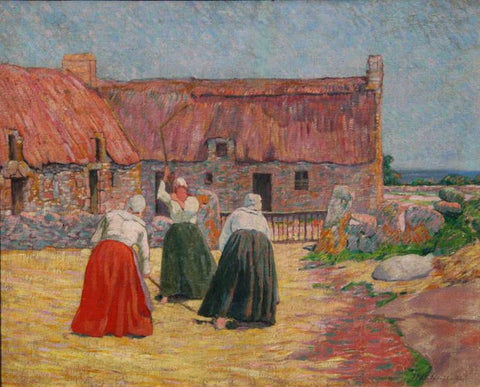
This is the first of three articles dedicated to the pleasure of owning art. This article is about wonder; the next one is about the collection of David Kabakoff, and the third one is about personal connections. But before I get too deep into the wonder of the etchings of Henri Delavallée in particular, I want to make one thing clear to those who happened to have wandered into this article by chance. Collecting art is about one thing only; that “thing” is joy, or a spark if you will; it’s about excitement, a smile on your face when you hold the work. Every work of art is an object. For that reason you should always try to hold it before you buy it. Whether it’s a painting, a print or a sculpture, you should literally take “it” in your hands, turn it around, feel its weight, and put your nose on it. You want to truly capture with your eyes every detail there is to see. The only way to do that is to hold the thing! Hold it up in natural daylight, angle it in raking light. Truly see it; form a bond with it. Don’t let the quiet gallery atmosphere intimidate you. A good art dealer understands that you’ll want to touch the object and see it in earnest.
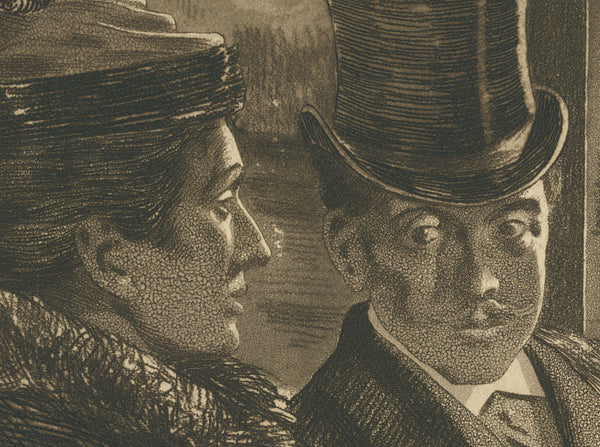
The second point I’ll make before I move on, is that you should not buy art based on where it will go. You can have a place in mind, in your home, office or wherever. That’s fine. But you can’t worry about that when you buy the work. Buy something you love; worry about placement later. If it happens to be too small to go over that couch you had in mind; well, eventually you’ll find something else to pair it with. If you bought a red square to go over your blue themed bed spread, no matter; instead of harmony it becomes a contrast. Just worry about loving the damned thing; nothing else matters.
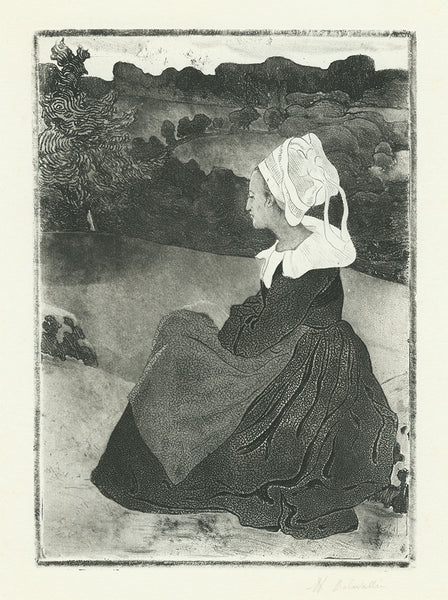
Now about Henri Delavallée, I’ll tell you why I’m so excited to have recently been able to add five of his etchings to the inventory. My interest goes back nearly two decades. There used to be a print fair in Los Angeles, held at the Los Angeles County Museum of Art, or LACMA for short. LACMA had taken an independent print fair, which had moved around various parts of the city for a decade or more, and professionalized it somewhat. At one of the early editions, Robert M. Light (1929-2016), known to all as Bob Light, had brought some works from the famed collection of Samuel Josefowitz (1921-2015). Whether they truly were from the Josefowitz collection is anyone’s guess, but the provenance was certainly likely. Bob Light was very well connected in the art world, and could get his hands on amazing objects. He could apparently also afford to sell art at high price points. He may have been wealthy enough to do so, or he may have simply had gumption; but he also seemed to get away with it. High-end collectors bought from him; museums in particular.
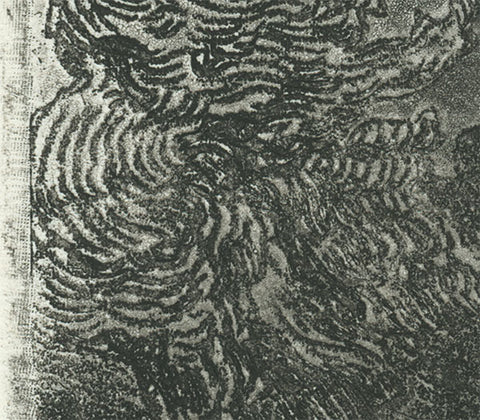
At that fair in LA, as I laid eyes on Bretonne en Noir by Henri Delavallée, I immediately fell in love with it. The texture of this print is amazing. The artist was able to create in aquatint the effect of lace throughout the woman’s dress. This pattern contrasts with the aquatint grain used for the hillside.
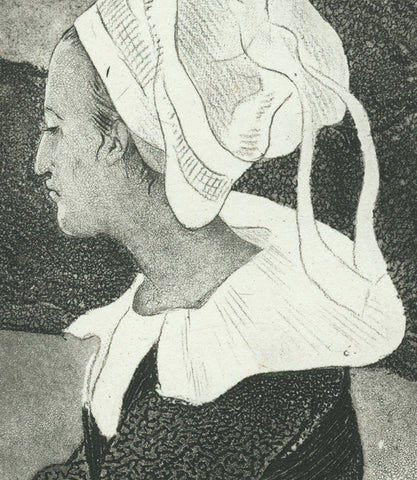
And her peaceful demeanor contrasts with the animated bush in the upper right corner, which was drawn with a gravelly soft-ground line. The sinewy line of the horizon and the bush suggest a concern on the woman’s mind. The use of the word “noir” or “black” paired with these compositional effects, clearly evokes her psychological state. Her face does not betray her mood, but her dress and her surroundings do. Did she come back from a funeral? Did she seek out this unsettled vista in order to confront an ailment or personal sadness? Whatever the story may be, and we as viewers get to decide in the end, this composition and its technical excellence transported me the very moment I saw it. I asked Mr. Light for the price, thinking he’d tell me it was $2000. I can’t swear to my recollection of his exact asking price; it was either $9000 or $7000. Either way it was far out of my reach, and I slouched away filled with sadness at having to let her go.
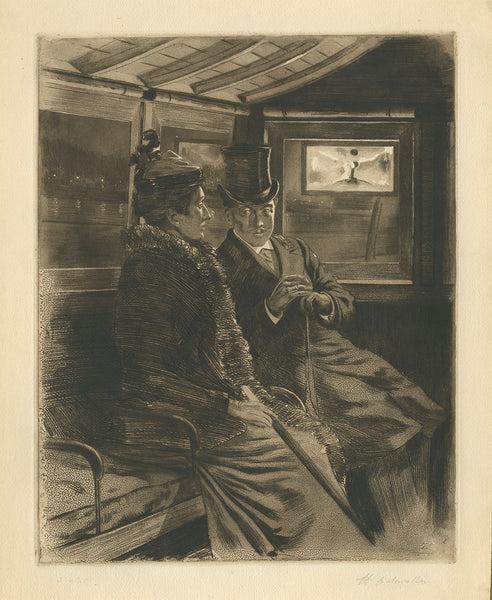
So imagine my joy when I was able recently, after all these years to become the proud owner of Bretonne en Noir. I bought it along with three other works by the artists; and just days ago purchased one more etching in Brittany, still on its way to me as I write this. Henri Delavallée is simply an amazing etcher, who sadly only made approximately 70 prints, two or three dozen of which are among the finest etchings I have ever seen. He was able to render textures and effects in aquatint with amazing dexterity. As described above, his aquatints are varied in grain and pattern, thus offering gray scales that are harmoniously contrasted and attractive. As a proud member of the School of Pont-Aven (Ecole de Pont-Aven), the use of cloisonné is done with talent. His sinuous lines, generally drawn in soft-ground etching, are decisive. His compositions are simple, but “colored” so to speak, to become almost painterly. It’s such a joy to be, if only temporarily, the owner of a few of his amazing works. They are scarce, as nearly none of his etchings were printed in their full editions of 50. You’ll see the odd published work come onto the market, and every so often a state impression will become available. But you can go a full year and not see a single good etching by Henri Delavallée come to market.
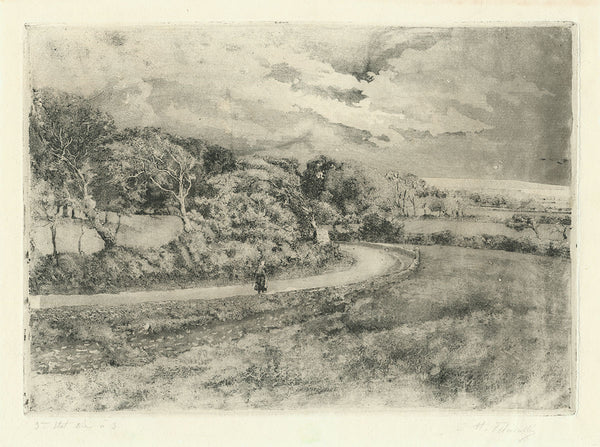
So, here is that opportunity. When these works are gone, you, my collector friend, will simply be out of luck; possibly for a long while! And know that this is not a sales pitch, it’s an earnest assessment. Every single one of the works by this artist listed on the site today is magnificent! The landscape with the woman walking on a path might as well be by Camille Pissarro. The gray scale is just that lovely as Pissarro would have drawn it. The trees are outlined with care; lines of darkness added along the limbs to contrast the light cast on them. The incoming weather is palpable.

And in Delavallée’s depiction of the Eiffel Tower and Seine River at night, just how dark city life was before gaslights, becomes tangible. If he had etched his composition any darker, you’d have a black rectangle. Yet, here it is, the modern tower, erected two years back, looming in darkness like an alien specter. The artist evokes just how eerie its presence must have been to Parisians in the 1890s.
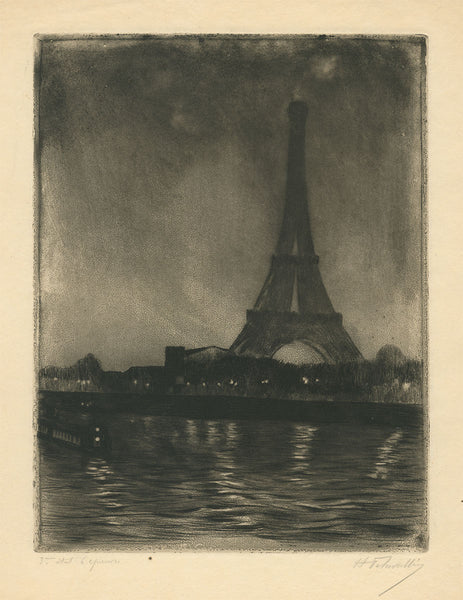
See our current inventory of works by the artist by clicking HERE.
Now, if Delavallée does nothing for you, that’s fine. Just keep in mind that to be a happy collector is to fall in love. Find something that moves you. And if you can afford it, you will never regret owning it.
